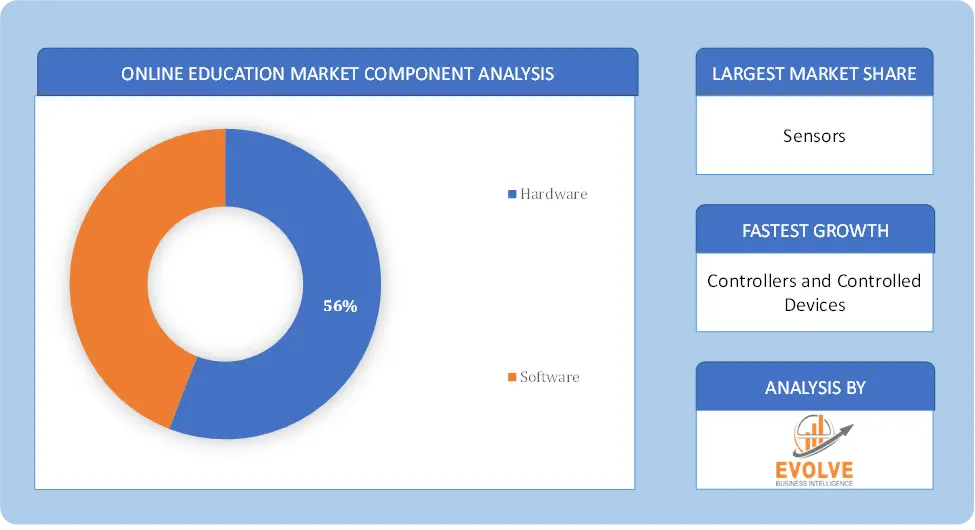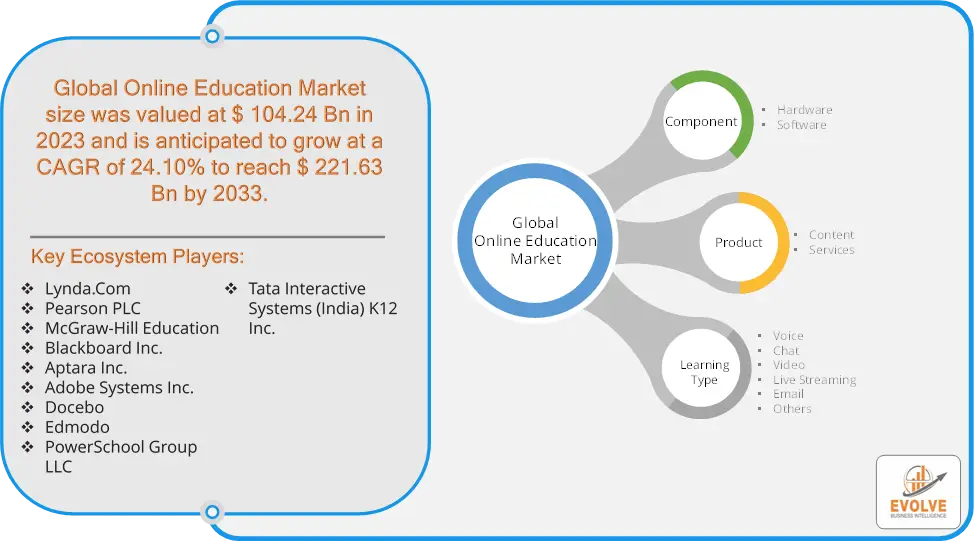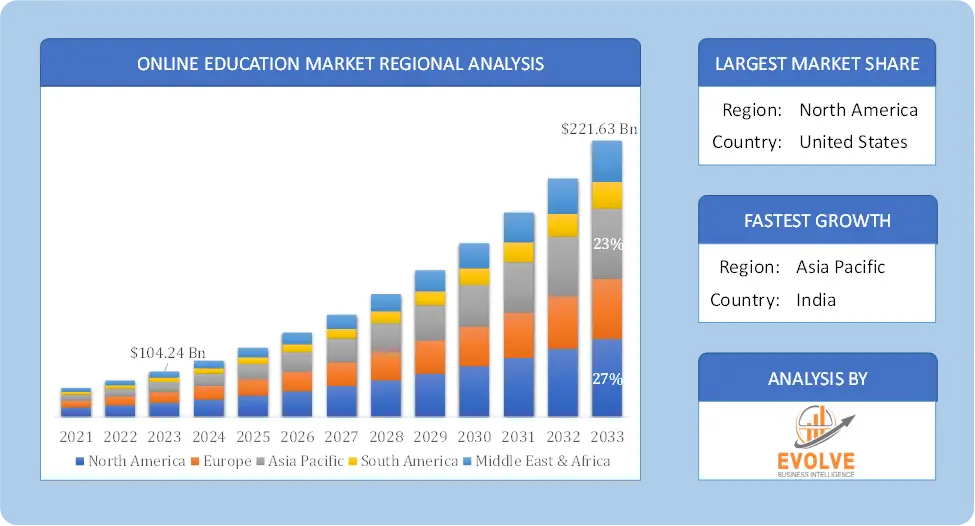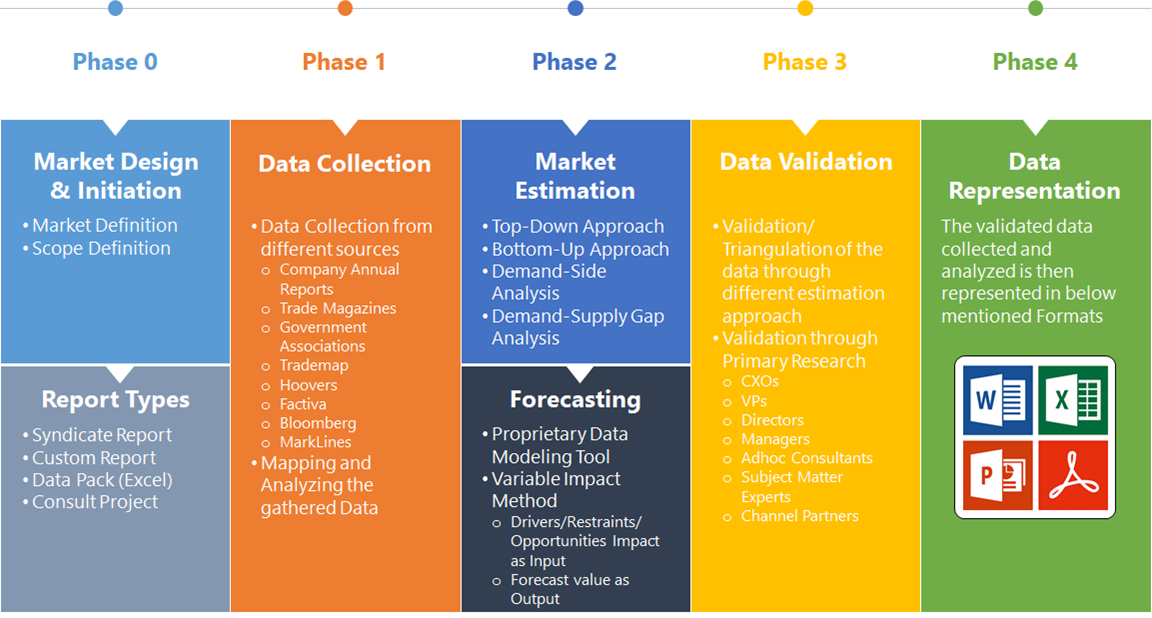Online Education Market Overview
The Online Education Market Size is expected to reach USD 221.63 Billion by 2033. The Online Education Market industry size accounted for USD 104.24 Billion in 2023 and is expected to expand at a compound annual growth rate (CAGR) of 24.10% from 2023 to 2033. The Online Education Market refers to the sector of the education industry that delivers learning experiences and educational content through digital platforms and technologies. The drill pipe market encompasses the production, distribution, and sale of hollow, cylindrical steel pipes used in the oil and gas exploration and production process. These pipes are essential components of drilling rigs, connecting the surface equipment to the drill bit at the bottom of the well.
The market has grown significantly due to factors like increasing internet penetration, the rise of mobile learning, and the demand for flexible and accessible education options. It includes various stakeholders such as educational institutions, corporate entities, content creators, and technology providers.
Global Online Education Market Synopsis
The COVID-19 pandemic had a significant impact on the Online Education Market. With lockdowns and social distancing measures in place, educational institutions and learners had to quickly adapt to online learning. This led to a surge in the adoption of online education platforms and tools. The demand for online education spurred technological innovations and improvements, such as enhanced video conferencing tools, more interactive LMS platforms, and better digital content delivery systems. Online education provided a flexible learning environment that could be accessed from anywhere, accommodating diverse learning needs and schedules. This flexibility became especially important as traditional classroom settings were disrupted. The pandemic highlighted the potential for online education to complement or even replace traditional classroom-based learning in some cases. This shift led to discussions about hybrid learning models and the future of education. Many educational institutions and organizations have continued to embrace online and hybrid learning models even after the pandemic, indicating a lasting change in the education sector.
Online Education Market Dynamics
The major factors that have impacted the growth of Online Education Market are as follows:
Drivers:
Ø Technological Advancements
Innovations in technology, including improved internet connectivity, mobile devices, and sophisticated e-learning platforms, facilitate the delivery of online education and enhance the learning experience. The widespread availability of high-speed internet globally enables more people to access online educational resources and participate in virtual learning. Online education often reduces costs associated with traditional education, such as commuting, accommodation, and physical materials. This cost-effectiveness makes education more accessible to a broader audience. There is an increasing emphasis on continuous learning and skill development to keep up with rapidly changing job markets and technological advancements, driving demand for online education.
Restraint:
- Perception of Personal Interaction and Privacy Issues
Online education often lacks the face-to-face interaction and social engagement found in traditional classrooms, which can affect the learning experience and student satisfaction. Online education platforms may face challenges related to data security and privacy, including concerns about the protection of personal information and intellectual property. Online learning requires a high degree of self-motivation and time management skills, which some learners may struggle with compared to more structured classroom settings.
Opportunity:
⮚ Growing demand for Corporate Training and Upskilling
The growing demand for employee training and development creates opportunities for online platforms to offer specialized corporate training programs, skill development courses, and certification programs tailored to industry needs. There is potential to develop more adaptive learning systems that use AI and data analytics to provide personalized learning experiences tailored to individual student needs, preferences, and progress. There is a growing market for innovative educational tools, resources, and interactive content that enhance engagement and retention, such as gamified learning and interactive simulations.
Online Education Market Segment Overview
By Component
 Based on Component, the market is segmented based on Hardware and Software. Software segment dominant the market. Any computer software designed for educational purposes is referred to as educational software. It covers a vast range of applications, from language learning software to classroom management software to reference software, and so on. This software exists to make some aspects of education more effective and efficient.
Based on Component, the market is segmented based on Hardware and Software. Software segment dominant the market. Any computer software designed for educational purposes is referred to as educational software. It covers a vast range of applications, from language learning software to classroom management software to reference software, and so on. This software exists to make some aspects of education more effective and efficient.
By Product
Based on Product, the market segment has been divided into Content and Services. The Content segment dominant the market. The live-streamed lectures are highly popular in online education. These can range from short instructional videos to full-length courses covering various subjects. There is a growing demand for content that is tailored to specific regions, languages, and cultural contexts, making it more relevant and accessible to a global audience.
By Learning Type
Based on Learning Type, the market segment has been divided into Voice, Chat, Video, Live Streaming, Email and Others. The Video segment dominant the market. Video content is highly engaging and helps in maintaining students’ attention, making it an effective tool for both synchronous (live) and asynchronous (pre-recorded) learning. Videos can be accessed on-demand, allowing learners to study at their own pace and review materials as needed. This flexibility enhances the learning experience.
By Verticals
Based on Verticals, the market segment has been divided into K-12, Higher Education, Industry & Professional and Others. K12 segment dominant the market. K12 segment refers to online education programs and courses that are designed for students in kindergarten through grade 12. This includes online courses for individual subjects, virtual classrooms, and digital curriculum systems that are used by teachers in K-12 schools.
Global Online Education Market Regional Analysis
Based on region, the global Online Education Market has been divided into North America, Europe, Asia-Pacific, the Middle East & Africa, and Latin America. North America is projected to dominate the use of the Online Education Market followed by the Asia-Pacific and Europe regions.
 Online Education North America Market
Online Education North America Market
North America holds a dominant position in the Online Education Market. The North American market, particularly the United States and Canada, is one of the largest and most mature markets for online education. The growth is driven by high internet penetration, technological advancements, and strong demand for flexible learning options and increasing adoption of corporate training solutions, advanced technologies like AI and VR, and a focus on higher education and professional development.
Online Education Asia-Pacific Market
The Asia-Pacific region has indeed emerged as the fastest-growing market for the Online Education Market industry. The Asia-Pacific region is experiencing rapid growth in online education, driven by increasing internet access, a large population of students, and rising demand for affordable education solutions and high growth potential, focus on mobile learning, and the development of localized content to cater to diverse cultural and educational needs.
Competitive Landscape
The global Online Education Market is highly competitive, with numerous players offering a wide range of software solutions. The competitive landscape is characterized by the presence of established companies, as well as emerging startups and niche players. To increase their market position and attract a wide consumer base, the businesses are employing various strategies, such as product launches, and strategic alliances.
Prominent Players:
- Lynda.Com
- Pearson PLC
- McGraw-Hill Education
- Blackboard Inc.
- Aptara Inc.
- Adobe Systems Inc.
- Docebo
- Edmodo
- PowerSchool Group LLC
- Tata Interactive Systems (India) K12 Inc.
Key Development
In April 2023, New VR course experiences from prestigious colleges and AR content from Meta are now available on Coursera. Virtual, mixed, and augmented worlds have the potential to revolutionize both work and education. They are pleased to share new VR-enabled course offerings from Duke University, Peking University, and the University of Washington that amplify the immersive nature of learning.
In March 2023, Stride and Rebel Girls partnered and created a collections of Rebel Girls book and audio recordings within its Stride Learning Hub, an online teaching tool that allows educators to customize each course with Stride activities, classes, and assessments.
Scope of the Report
Global Online Education Market, by Component
- Hardware
- Software
Global Online Education Market, by Product
- Content
- Services
Global Online Education Market, by Learning Type
- Voice
- Chat
- Video
- Live Streaming
- Others
Global Online Education Market, by Verticals
- K-12
- Higher Education
- Industry & Professional
- Others
Global Online Education Market, by Region
- North America
- US
- Canada
- Mexico
- Europe
- UK
- Germany
- France
- Italy
- Spain
- Benelux
- Nordic
- Rest of Europe
- Asia Pacific
- China
- Japan
- South Korea
- Indonesia
- Austalia
- Malaysia
- India
- Rest of Asia Pacific
- South America
- Brazil
- Argentina
- Rest of South America
- Middle East & Africa
- Saudi Arabia
- UAE
- Egypt
- South Africa
- Rest of Middle East & Africa
| Parameters | Indicators |
|---|---|
| Market Size | 2033: $221.63 Billion |
| CAGR | 24.10% CAGR (2023-2033) |
| Base year | 2022 |
| Forecast Period | 2023-2033 |
| Historical Data | 2021 |
| Report Coverage | Revenue Forecast, Competitive Landscape, Growth Factors, and Trends |
| Key Segmentations | Component, Product, Learning Type, Verticals |
| Geographies Covered | North America, Europe, Asia-Pacific, Latin America, Middle East, Africa |
| Key Vendors | Lynda.Com, Pearson PLC, McGraw-Hill Education, Blackboard Inc., Aptara Inc., Adobe Systems Inc., Docebo, Edmodo, PowerSchool Group LLC and Tata Interactive Systems (India) K12 Inc |
| Key Market Opportunities | • The growing demand for Corporate Training and Upskilling • Customizable and Adaptive Learning |
| Key Market Drivers | • Technological Advancements • Cost-Effectiveness |
REPORT CONTENT BRIEF:
- High-level analysis of the current and future Online Education Market trends and opportunities
- Detailed analysis of current market drivers, restraining factors, and opportunities in the future
- Online Education Market historical market size for the year 2021, and forecast from 2023 to 2033
- Online Education Market share analysis at each product level
- Competitor analysis with detailed insight into its product segment, Government & Defense strength, and strategies adopted.
- Identifies key strategies adopted including product launches and developments, mergers and acquisitions, joint ventures, collaborations, and partnerships as well as funding taken and investment done, among others.
- To identify and understand the various factors involved in the global Online Education Market affected by the pandemic
- To provide a detailed insight into the major companies operating in the market. The profiling will include the Government & Defense health of the company’s past 2-3 years with segmental and regional revenue breakup, product offering, recent developments, SWOT analysis, and key strategies.







